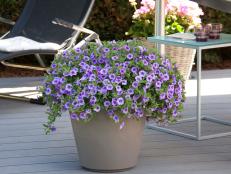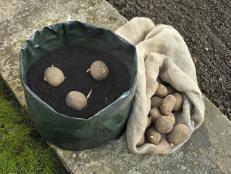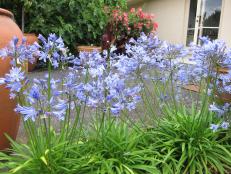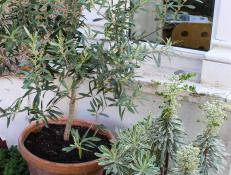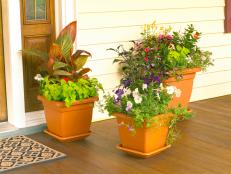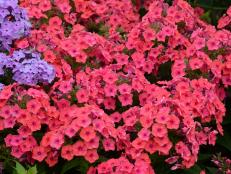How to Plant and Grow Marigold Flowers
Easy-to-grow marigolds add bright yellow, gold, orange and creamy-white color to gardens and containers from spring into fall.
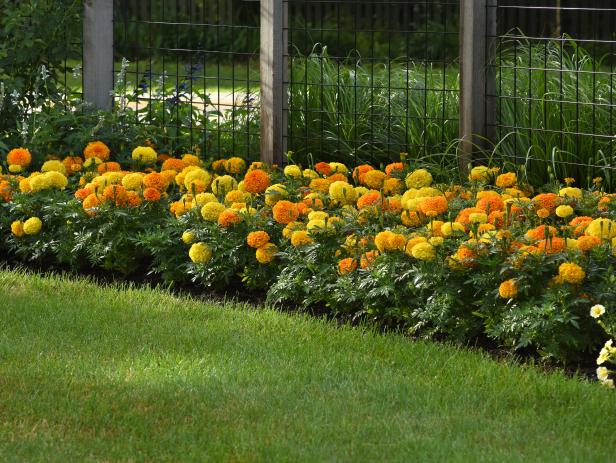
PanAmerican Seed/Kieft
'Marvel II' is an African marigold with sturdy stems that hold up in bad weather. Plants and seeds are available in bright gold, yellow, orange and mixed colors.

Cheerful marigolds (Tagetes species) dress up your garden from spring until frost. Look for them in shades of yellow, orange, white, red or gold. These easy-to-grow annuals rebloom readily if they're kept deadheaded. Grow a marigold garden for bright color or use them as companion plants to help deter pests around vegetables and other ornamentals.
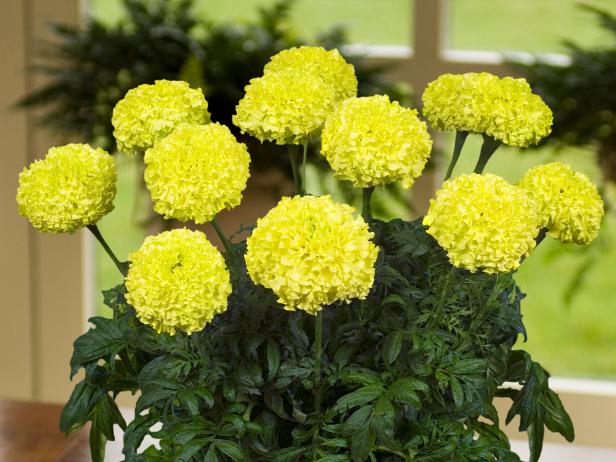
Grow Nosento 'Limegreen' if you're not fond of the way marigolds smell. The nearly scentless flowers are lime green to pale yellow.
Choosing Which Marigolds to Grow
Species, Cultivars and Varieties
There are more than 50 species of marigolds, although African marigolds, French marigolds and signet marigolds are usually the most popular. They're available from online plant and seed sellers, nurseries and home and garden centers.
African marigolds (Tagetes erecta). These are the tallest marigolds, so they’re a good choice for the back of borders. ‘Vanilla’ is a creamy-white African marigold while 'Proud Mari' comes in yellow, orange and gold.
French marigolds (T. patula). Compact French marigolds range from about 6 to 18 inches tall. Grow them in containers or the front of the border.
Signet marigolds (T. tenuifolia). These small, bushy plants have edible marigold flowers with a tarragon-like flavor.
Mexican marigold (T. lemmonii). Also called Lemmon's marigold, shrubby Mexican marigold plants have lemon and mint-scented leaves and daisy-like flowers. This is a perennial marigold, hardy in USDA Zones 8 to 11.
Marsh marigold (Caltha palustris). A member of the buttercup family and not a true marigold, this is another marigold perennial. Hardy in Zones 2-7, marsh marigold tolerates full sun to full shade on stream banks and near other water features. Marsh marigold seeds take a long time to germinate and reach maturity.
Desert marigold (Baileya multriadiata). Also called paper daisy, desert marigold is not a true marigold. This short-lived marigold perennial has yellow flowers and needs little care.
Pot marigold (Calendula officinalis). Commonly called pot marigold, this cool-season annual can come back as a short-lived perennial in Zones 9 to 11. It’s not a true marigold, either. Best grown in early spring, pot marigolds have bright yellow and gold blooms
Mexican tarragon (T. lucida). Also called Mexican marigold mint, among other names, Mexican tarragon has yellow flowers. It needs partial shade to full sun and fertile, well-drained soil.
Getting the Planting Site Ready
Give marigolds a site in full sun. They can tolerate a little shade, however, in areas with hot afternoon sun.
Loosen the soil for your marigold garden about six inches deep and remove stones and other debris. Marigolds like moderately fertile, loamy soil, so you may want to test yours or ask your local extension service to test it for you. The results will tell you what amendments you need, if any. Marigolds also need soil that drains easily, so you may want to work in some organic matter.
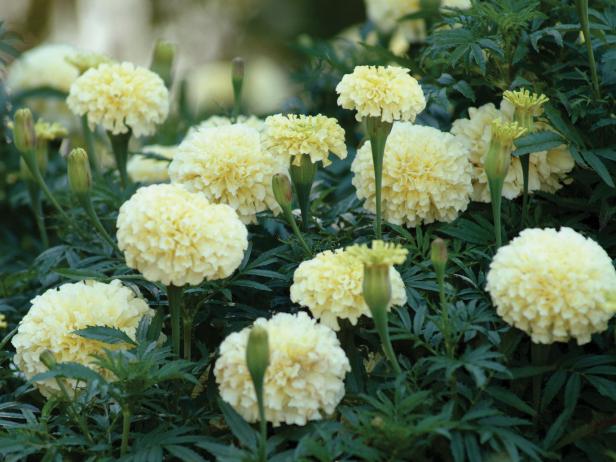
PanAmerican Seed
'Vanilla' is a creamy-white marigold with doubled blooms. It has strong resistance to Botrytis, a fungal disease also known as gray mold.
If you don’t test your soil, or you don't think it has sufficient nutrients for plants, work in some slow-release granular fertilizer as indicated on the product’s label. Alternately, plan to water with diluted liquid fertilizer.
Planting Marigolds
When to Plant Marigold Seeds
Wait until all danger of frost has passed before planting marigold seeds or marigold seedlings directly in your garden. Set out marigolds from spring into midsummer, but start African marigold plants as soon as the soil is warm because they take a long time to flower.
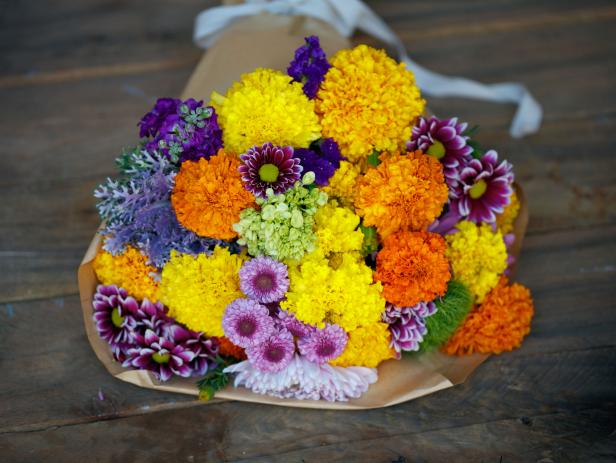
Scott Morando/Sakata
Marigolds make good cut flowers, although they're not often used in bouquets or arrangements, probably because of their strong scent. Shown here: Yellow, deep orange and gold marigolds in the 'CoCo' series.
Should I Start Marigold Seeds Indoors?
Planting marigold seeds indoors is easy and most varieties sprout in a few days. To know when to start the seeds, read the seed packet for your variety and count backward from the date of your last expected frost.
Sow the seeds in a seed starting mix one inch apart and one inch deep and water them in. Thin the marigold seedlings while they’re about two inches tall, leaving signet and French marigold seedlings 8 to 10 inches apart and African marigold seedlings 10 to 12 inches apart.
After all danger of frost has passed, transplant the marigold seedlings into the garden or containers, spacing them as directed on your seed packet.
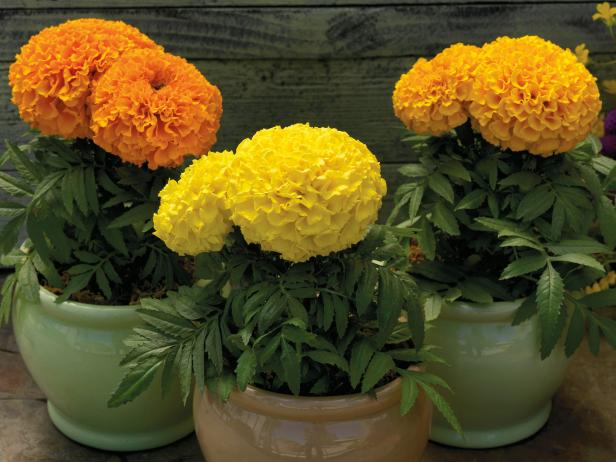
Kurt Reynolds/Sakata Seeds
Available in three colors, shown here, 'Proud Mari' marigolds have fully double flowers and a uniform height.
Planting Marigolds in the Garden
Give tall marigold plants a spot where they won’t be beaten down by strong winds and rain. Even in a sheltered site, they may need staking.
Moisten the soil and start marigold seeds in the garden after all chance of frost has passed. Sow them one inch apart and one inch deep. Water them in. When the seedlings pop up, thin signet and French marigold seedlings to every 8 to 10 inches and African marigold seedlings to every 10 to 12 inches.
Growing and Caring for Marigolds
Water Regularly
Water regularly but let the soil dry slightly between waterings. Avoid watering overhead since wet foliage can lead to fungal diseases.
When to Fertilize
Once your marigolds are actively growing, don’t fertilize them again if you added slow-release granular fertilizer at planting time. Too much nitrogen promotes foliage over flowers. If you didn't fertilize at planting time, use a diluted liquid fertilizer as directed on the label.
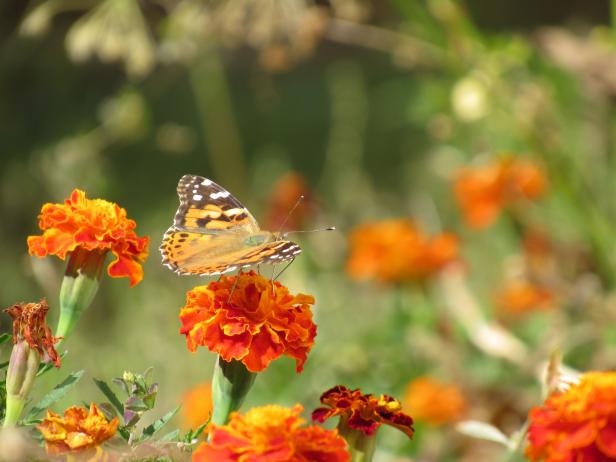
Angie Sparks/American Meadows
Marigolds provide nectar for butterflies and honeybees, like these flowers grown from American Meadows seeds.
Weed Regularly
Weed marigolds regularly and mulch around them to discourage weeds. Mulch also helps hold moisture in the soil.
Scout For Health Issues
Few pests and diseases bother marigolds, although spider mites, whiteflies and aphids can be a problem. As soon as you spot pests, spray your plants with water or an insecticidal soap solution. Repeat every other day for a week or two or until the pests disappear.
Slugs can also damage marigolds. Use commercial slug bait or dig a shallow hole in your garden and drop in a tuna can filled with beer. Slugs will fall in and drown. You can also put an upside-down melon rind near the marigolds and discard it when the slugs crawl aboard.
Keep marigold leaves dry to discourage diseases like powdery mildew and gray mold. If needed, use a commercial fungicide for your specific problem and follow the label directions. Soil that drains well will help discourage fungal problems and root rot.
How to Use Marigolds in the Garden
Strong-scented marigolds can help deter pests from vegetables, including tomatoes, squash, bush beans and cucumbers. French marigolds are said to repel whiteflies and, if the plants are turned under at the end of the growing season, destructive nematodes.
Deer usually avoid marigolds because of their pungent scent, so marigolds planted with other ornamentals and shrubs may help protect them.
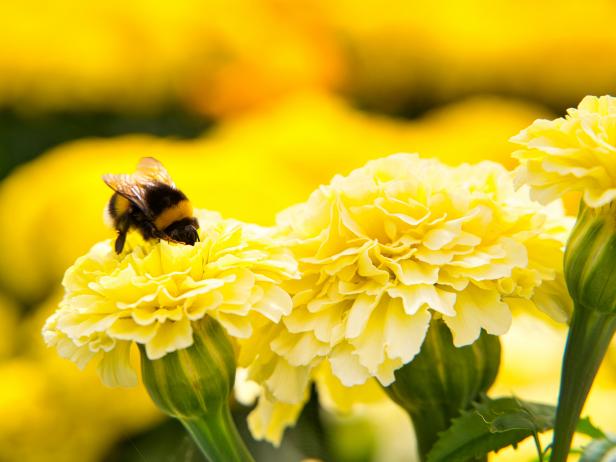
Daniel Vos/Ball Horticultural Company
Avoid using chemicals in your marigold garden so helpful pollinators like bees can visit safely. This yellow variety is one of many from Ball Horticultural Company.
Try planting marigolds in a border around your garden or use them at random in the rows. Mix up their sizes and colors or go for a uniform look.
Planting marigolds can attract beneficial insects to your garden, such as bees and aphid-eating ladybugs.
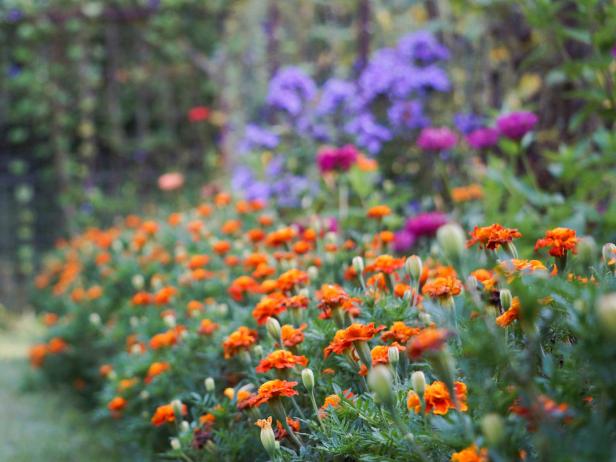
Kalea Jerielle/American Meadows
Use shorter marigolds in front of perennials or other annuals in complementary colors like purple, blue and lavender. American Meadows sell marigold seeds and wildflower, grass and other seeds.
Use marigolds in borders, containers, window boxes, herb gardens and hanging baskets. In perennial beds, they’ll add color when your perennials aren’t blooming. Tall marigolds are attractive behind shorter flowers and when planted in front of fences.

.-Battle-on-the-Beach-courtesy-of-HGTV.-.jpg.rend.hgtvcom.196.196.suffix/1714761529029.jpeg)




